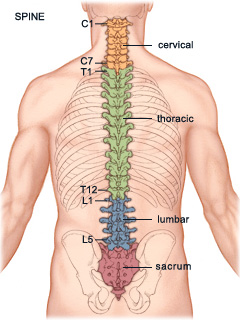- Our Team
- Construction Accidents
- Practice Areas
- Settlements
- Resources
- Español
- Contact Us
- (212) 668-6000
- Our Team
- Construction Accidents
- Practice Areas
- Settlements
- Resources
- Español
- Contact Us
- (212) 668-6000
X
- Our Team
- Construction Accidents
- Practice Areas
- Settlements
- Resources
- Español
- Contact Us
- (212) 668-6000
- Home
- New York Spine Injury Lawyers
New York Spine Injury Lawyers

The spinal cord acts as the main information pathway between the brain and the rest of the body. Therefore a spinal cord injury can have significant physiological consequences. The segment of the cord that is injured, and the severity of the injury, will determine which bodily functions are compromised or lost.
Most spinal injuries do not completely sever the spinal cord. Instead, an injury is more likely to cause fractures and compression of the vertebrae.
Spinal Injury Can Take on Several Forms
- “Complete” Injury which causes an absence of motor or sensory function below the occurrence.
- “Incomplete” injury which results in partial sensation or movement below the level of injury.
- Soft tissue injuries (eg: for example “whiplash”, sports injuries, etc.).

Catastrophic falls, such as being thrown through a windshield, falling at a construction site, being struck by heavy machinery or other kinds of physical trauma that crush and compress the vertebrae in the neck can cause severe damage at the cervical level of the spinal cord and below.
There are over 10,000 cases of spinal cord injury reported in the U.S. each year. The majority are due to auto accidents, or work-related injuries, however, any form of severe trauma can cause an injury to the spine.
Common types of spinal injuries result from:
- Auto accidents and motorcycle accidents
- Pedestrian Accidents
- Work-related accidents
- Violent Crimes
- Machinery related accidents
- Recreational accidents
The effects of injuries to the lumbar or sacral regions of the spinal cord are often decreased control of the legs, hips and urinary system.
Determining the exact level of injury is critical in making accurate predictions about the specific parts of the body that may be affected:
- Cervical vertebrae (1-7) are located in the neck
- Thoracic vertebrae (1-12) located in the upper back (attached to the ribcage)
- Lumbar vertebrae (1-5) are located in the lower back
- Sacral vertebrae (1-5) are found in the hip area
- Coccygeal vertebrae (1-4 fused) are located in the tailbone
Common Systems of Spinal Injury
- Loss of sensation and motor function below the level of injury
- Problems breathing
- Pneumonia
- Irregular heartbeat
- Blood pressure instability
- Blood Clots
- Pressure sores due to lack of movement
- Bowel and bladder problems
- Sexual dysfunction
- Muscle atrophy
Stimulated by significant federal and private funding over the past several years, spinal injury research has produced a wealth of promising discoveries. This is good news for the thousands of Americans who sustain traumatic injuries in the U.S. each year.
How We Deal With Insurance Companies Refusing to Pay for Spine Injuries
At Hill & Moin, we understand that dealing with insurance companies can be one of the most challenging aspects of a spinal cord injury case. Insurance providers often attempt to minimize payouts, delay claims, or outright deny compensation for spinal cord injuries, even when the damage is life-altering. Here’s how our experienced spinal cord injury lawyers navigate these challenges to secure justice for our clients in New York City:
- Gathering strong evidence: To counter any attempts by insurance companies to dispute the severity of injuries, we work tirelessly to build a compelling case. We collaborate with medical experts, physical therapists, and accident reconstruction specialists to provide detailed evidence of the injury’s impact on your life. This includes medical records, diagnostic imaging, and expert testimony to substantiate your personal injury claim.
- Demanding full coverage for catastrophic injuries: Spinal cord injuries are often catastrophic and require long-term medical care, including surgeries, rehabilitation, and physical therapy. We fight to ensure that insurance companies honor their commitments to cover these substantial costs. Whether the injury stems from workplace accidents, auto collisions, or medical malpractice, we demand full compensation for both current and future expenses.
- Negotiating aggressively: Insurance companies prioritize their bottom line, which often leads to lowball settlement offers. Our skilled negotiators are well-versed in personal injury cases and will not back down until we achieve a settlement that reflects the true value of your claim.
- Taking the case to court when necessary: If an insurance company refuses to act in good faith, Hill & Moin is fully prepared to take the case to trial. Our attorneys are seasoned litigators with a proven track record in New York City courtrooms. We will present a compelling argument to secure the compensation you deserve for your spinal cord injury.
- Handling the process for you: Dealing with paperwork, deadlines, and constant pushback from insurance adjusters can be overwhelming, especially when recovering from back injuries or undergoing physical therapy. Our team takes care of every detail so you can focus on your recovery.
Why Choose Hill & Moin, LLP
Choosing the right legal representation can make all the difference in your personal injury case. Here’s why Hill & Moin stands out as the go-to choice for spinal cord injury cases in New York City:
- Proven experience in spinal cord injury cases: Our attorneys have decades of experience handling cases involving catastrophic injuries, including spinal cord and back injuries. We understand the complexities of these cases and have a track record of securing favorable outcomes.
- Compassionate and client-centered approach: We know that a spinal cord injury is more than just a legal matter—it’s a life-changing event. Our team treats every client with the care and compassion they deserve, ensuring their voice is heard throughout the process.
- Comprehensive knowledge of New York laws: Navigating New York’s legal landscape, particularly in medical malpractice and workplace accidents, requires in-depth knowledge. Hill & Moin’s attorneys are experts in the state’s personal injury laws and have a deep understanding of how to maximize compensation for our clients.
- Access to top experts: We work with leading medical professionals, physical therapy specialists, and vocational experts to build strong cases that demonstrate the full extent of your injuries and losses.
- “Dynamic representation” promise: At Hill & Moin, we pride ourselves on our “Dynamic Representation” approach. This means we take the initiative in every aspect of your case, ensuring no opportunity is missed to secure the best possible result.
- No fees unless we win: We operate on a contingency fee basis, meaning you don’t pay anything unless we win your personal injury claim. This commitment ensures our interests are fully aligned with yours.
- Proven results: Over the years, we’ve helped thousands of clients secure significant settlements and verdicts in personal injury cases. Whether you’re dealing with a spinal cord injury, back injuries, or other catastrophic injuries, Hill & Moin, LLP has the expertise to deliver results.
If you or a loved one has suffered a spinal cord injury due to medical malpractice, workplace accidents, or another form of negligence, Hill & Moin, LLP is here to help. Let us fight for your right to fair compensation so you can focus on rebuilding your life.
Let Hill & Moin, LLP Fight for Justice for Your Spine Injuries
After experiencing a spinal cord injury in New York, you need a dedicated and results-driven legal team on your side. At Hill & Moin, we understand the devastating physical, emotional, and financial toll that back and spine injuries can cause. Our experienced attorneys are committed to thoroughly investigating your case, determining liability, and fighting for the compensation you deserve.
Spinal cord injuries often lead to significant medical expenses, ongoing physical therapy, and life-altering challenges. You can rely on Hill & Moin, LLP for compassionate, skilled representation as we advocate for your rights and work to secure your future.
Don’t wait to take action. The sooner you seek justice, the sooner you can begin your journey toward recovery and peace of mind. Call Hill & Moin, LLP today at (212) 668-6000 for a free case evaluation, or contact us online, and we will reach out to you promptly.
Let Hill & Moin guide you toward the justice and support you deserve.
Free Consultation
© 2025 Hill & Moin LLP. All Rights Reserved. | Sitemap | Privacy Policy | Disclaimer | Attorney Advertising: Prior results do not guarantee a similar outcome.
212-210-1965

